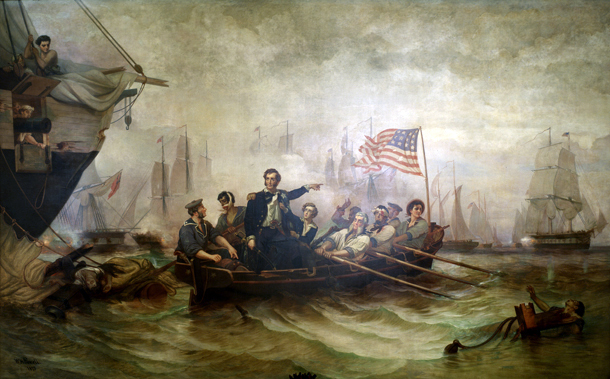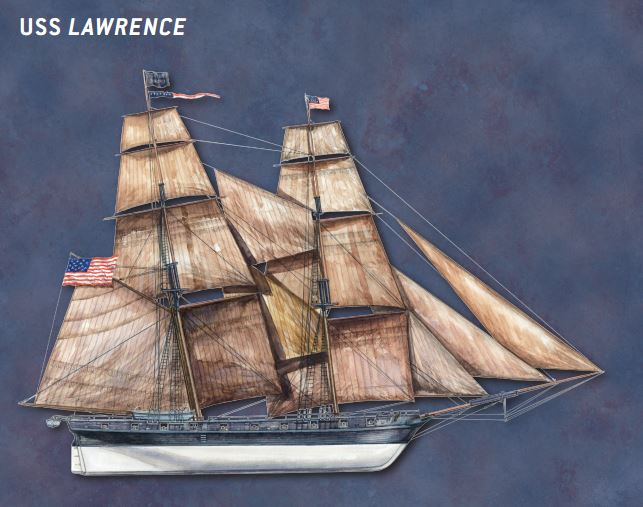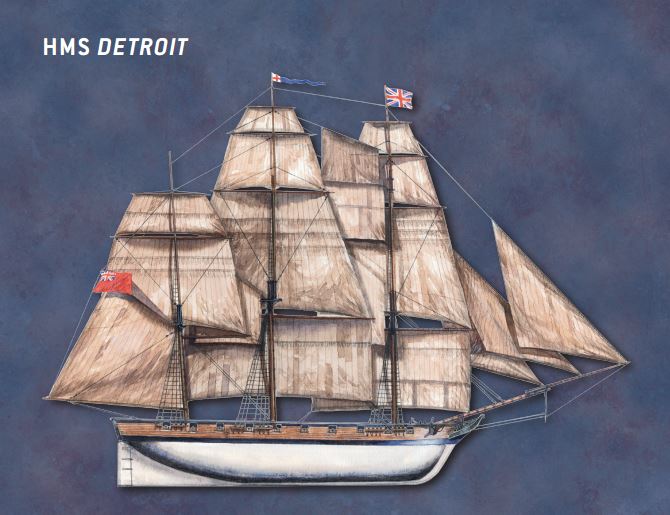Today on the blog post we welcome Osprey author Mark Lardas, who discusses how he came to write Duel 79: 'USS Lawrence vs HMS Detroit'
How did I end up writing Lawrence vs Detroit? There is a story there.
Nick Reynolds, commissioning editor for Duel, contacts me, inviting me to submit a proposal for a Duel involving Great Lakes warships during the War of 1812.
First rule of being an author: always accept invitations. Editors rarely invite proposals. The normal course of nature is the author humbly presents himself to the editor, stating “Sir (or ma’am) would you possibly consider accepting a proposal on such-and-such a topic.” The editor, from a perch on Olympus replies “Well . . . maybe,” and you are off from there.
Of course I was interested. If I had a tail, it would have thumped the floor. The Age of Fighting Sail has fascinated me since I was a child. I have written more about sailing-era combat than any other topic. Lakes warfare during the War of 1812 was particularly close to home, literally. I grew up in Southeast Michigan, visited the site of the Battle of Lake Erie in my teens (with the added bonus I flew there on one of the last remaining commercial Ford Tri-motors), and regularly wargamed Lakes actions in high school and college.
There was just one problem: no satisfactory single-ship actions were fought on the Lakes during the War of 1812. The one-on-one actions fought were either grossly unequal or one side fled as soon as it began to experience difficulties. Captains – on both sides – were willing to fight only if they felt victory was guaranteed. The only hard-fought, decisive battles fought on the Lakes were the Battle of Lake Erie and the Battle of Lake Champlain.
To my mind, a naval Duel should focus on battles between two ships, preferably uninfluenced by other ships. Duel is supposed to be about two dueling opponents. Throw in a third party and it is not a duel; it is a brawl. I have not always stuck to that. The Battle of Flamborough Head was technically a multi-ship action, but Bonhomme Richard vs. Serapis was virtually a single ship action (albeit with Alliance attacking both sides). Lake Erie and Lake Champlain were both squadron actions, and Lake Champlain was fought anchored.
 William Henry Powell's painting "Perry's Victory on Lake Erie"
William Henry Powell's painting "Perry's Victory on Lake Erie"
I really wanted to write this Duel. I had a lot of images appropriate for the War of 1812 on the Lakes. (One curse of being an author is you find lots of great images on a topic after your book on that topic comes out.) It offered an opportunity to provide fresh perspectives on naval aspects of the Age of Fighting Sail. After four Duels on sailing-era naval warfare it is easy to repeat yourself.
Ships built for fresh water sailed and fought differently than ship built for salt water. I touched on the reasons in Great Lakes Warships, but Duel includes Design and Development and Technical Specifications sections where I can expand the discussion. A Lakes Duel would likely involve a class of warship I had not previously discussed – the sloop-of-war, ships with one gun deck and no guns mounted elsewhere. Despite the presence of ships-of-the-line and frigates on the lakes, the hard fighting was done by sloops-of-war.
I hated saying no, but without one-on-one combat you do not have a Duel. It sure was a shame there were no suitable single-ship actions to hang the book on.
Or were there? I decided to take a closer look at the Battle of Lake Erie before responding to Nick.
I often wargamed the battle during my gaming days. It is a great multi-ship action for a game like Wooden Ships and Iron Men, although I found it useful to triple all the gunnery, crew, and damage values, so the smaller ships could take part. The United States inevitably won and won pretty easily. The battle was more fun when gamed multi-player using the old Don’t Give Up the Ship miniatures rules, intended for single-ship combat. If you could get 10 people the battle was a blast because you could not coordinate things as perfectly as you could when one person controlled all ships on each side. The British usually held their own.
As I reread accounts of the battle, I realized this game behavior offered a valuable clue. The Battle of Lake Erie was less a squadron action than it was a set of single-ship duels. First, there was duel between Lawrence and Detroit, followed by a duel between Niagara and Detroit. Yes there were twelve other ships on the game board, but those three did all of the decisive fighting.
This is not to say the other ships did not fight and did not take damage and casualties. They did. It is just that the battle was decided by the two single-ship actions. The question was why?
It is true those three ships were the most heavily armed vessels in the battle. Theoretically Queen Charlotte, a sister ship of Detroit, should have contributed as much to the battle as Detroit, but for some reason it did not. At this point I did not know why. What I did know, was I had an Osprey Duel, as a book on the Battle of Lake Erie could focus on the two single-ship actions. I sent off a proposal framed on that. It was accepted, and the rest is history. (Or rather, writing history.)
I suppose some readers think I have all of the answers when I start writing a Duel. In reality, I usually start out with a series of questions that I set out to answer. I have what I think are answers, but I start by assuming all of my answers are wrong until I can prove they are right.
From my perspective, the Battle of Lake Erie was a great project because it had so many really interesting questions. Among them:
- Why did Queen Charlotte play such a minor role during the battle?
- Why did Jesse Elliot (captain of Niagara) fail to engage more closely?
- Why did the ships fight as individual units and not as a coordinated squadron?
- Since the British were so badly outgunned, why did Robert Barclay (the British commander) fight in the first place?
- How close to victory did the British get?
It also gave me a chance to discuss the sloop-of-war and the difference between fresh-water and salt-water sailing ships. Plus discuss the difficulties of building two fleets in the middle of an isolated wilderness. (There were reasons frigates and ships-of-the-line got built on Lake Erie and Lake Champlain, but only single-deck sloops-of-war were built on the upper lakes.)
My biggest surprise was the discovery that the decisive factor in the Battle of Lake Erie was less the ships and the way that they were armed than it was the crews who manned the ships and the weather on the day of the battle. Crew quality explained more than I imagined. It explained why the battle ended up as a series of single-ship battles, instead of a coordinated squadron action. Crew quality, combined with the light winds on the day of the battle also explained why Queen Charlotte played a marginal role in the fight and why Niagara failed to engage in the first phase of the battle.
It was not that the basic manpower material on both sides was that bad. Despite using soldiers to man ships, both sides could have had great crews – if they had time to work together. Instead what they had were crews capable of handling the basics, but not much else. In most cases ships’ crews had been aboard less than two months before the battle was fought. The ability to do anything beyond the most basic maneuver – things considered routine on a warship whose crew had worked together for six months – was beyond their capabilities.
Neither side could risk tacking (turning into the wind) their ships under combat conditions. It was too likely they would get stuck in mid-maneuver, and left helplessly immobile. Similarly if one ship fell behind the next ahead in the line the ships behind it could not sail around the laggard without risking falling out of range of the enemy line or blocking the gunfire of their own ships.
When ships attempted something complex (such as Detroit turning to keep from being raked by Niagara while Queen Charlotte simultaneously attempted to get in position to rake Niagara) the results were disastrous. (Detroit and Queen Charlotte collided, rendering both helplessly immobile).
The result? Two squadrons which fought a series of individual ship-to-ship duels. Lawence fought Detroit, while Caledonia fought General Hunter as Niagara fought Queen Charlotte. Then after Queen Charlotte ducked behind General Hunter it sort-of, kind-of helped Detroit against Lawrence, while Nigaraga, commanded by the brave, but unimaginative Jesse Elliot parked itself out of the battle like a proverbial stump turtle. Meanwhile the various schooners, armed with one or two guns sniped at various targets of opportunity.
And, the battle was decided when Perry, unwilling to accept defeat with a perfectly good and largely undamaged warship at his disposal, took command of Niagara and sailed it against Detroit. One more single-ship battle forced Detroit to turn away and collide with Queen Charlotte, decisively settling things.
Had the wind been stronger, allowing the green crews more latitude to maneuver it would have been a different battle. (It is easier to tack with moderate winds.) Had the crews more time to work together, and learn how to maneuver their ships it would have been a different battle. In both cases it would have been more likely to have been a traditional squadron action, with ships of one side working in coordination. Instead the combination of wind and crew quality conspired to create a unique battle, one where the ships fought individually and one determined captain (and both Barclay and Perry were determined) could change the outcome.
You can now pre-order Mark's latest book, USS Lawrence vs HMS Detroit by following the link here.



Comments
You must be logged in to comment on this post. Click here to log in.
Submit your comment